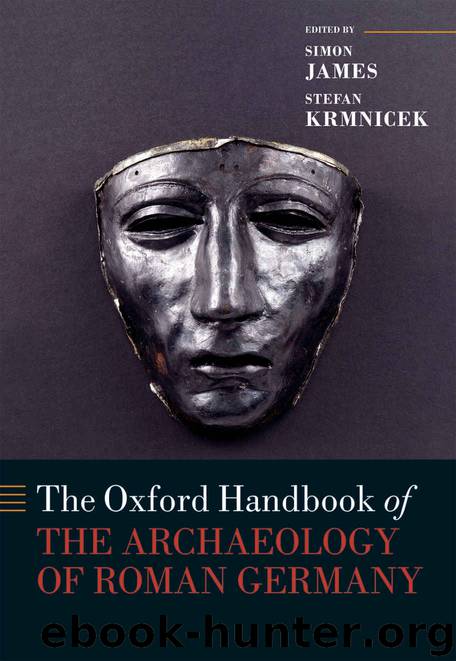The Oxford Handbook of the Archaeology of Roman Germany (Oxford Handbooks) by Simon James & Stefan Krmnicek

Author:Simon James & Stefan Krmnicek
Language: eng
Format: azw3, epub
ISBN: 9780191644023
Publisher: OUP Oxford
Published: 2020-03-18T16:00:00+00:00
Chapter 12
Provincial Art
Alexandra W. Busch and Henner von Hesberg
Introduction: On the concept and meaning of ‘provincial art’
The concept of ‘art’ is often linked to fine art (or figurative art). Fundamentally it is conceived as a closed entity that can be isolated, and in which the images or artefacts can be distinguished from other objects through their aesthetic quality. The traditional notion of fine art is thus primarily perceived in the form of sculpture and painting, and is therefore bound to objects whose specific presentation establishes their autonomous position in public awareness. Relevant works on ‘Roman art’ (e.g. Andreae 1982; Zanker 2015) promote this vision. Hence utilitarian artefacts like vessels, lamps, and countless other types of objects such as textiles fall into the category of crafts, that is to say the applied arts, and are often valued on a level below ‘art’. The same applies to ornamental architecture and to material manifestations in a specific context, such as the arrangement of dishes on a table, to cite but one example.
The supposedly precise definition of ‘provincial art’ in Roman times moreover suggests that artistic expression in the provinces of the Roman Empire can be separated from that produced in its centre; in other words, that the relevant works have specific attributes and traits that can be identified and whose quality can be distinguished from those created in Rome (for a critical approach see Scott and Webster 2003: 1). In addition, the label ‘provincial’ is somewhat equivocal; indeed the relevant publications often do not specify whether the assemblage of artistically created objects within a province includes those that were imported, or whether it only refers to the objects that were produced there.
In our consideration of works created within the territories of the Roman provinces of Germany, we shall be dealing with a ‘provincial art’ that has been expanded conceptually in two ways. We take it to encompass all the images produced in a province. The approach chosen thus looks beyond individual works of art towards very diverse forms of expression. The factor that we consider as decisive for the connections we wish to explore is less the quality of objects as works of ‘art’ and much more their capacity to convey information. Images were made on purpose, employed as a medium, perceived, and used. Their creation, as much as their use, gives insights into people, their behaviour, and their cultural affiliations. Our environment, like that of antiquity, is full of images; we can master these only with great difficulty if we try to slot them into the categories predetermined by our various disciplines.
In this chapter, then, we aim to analyse the images of the Roman provinces of Germany as a medium, and hence their ability to communicate. Our focus will be on images which have survived either directly or indirectly, since we are inevitably dependent on the vagaries of survival. That ‘images’ were also produced outside those bound to fixed objects, attached to combinations of objects or to performative acts—within representative art and beyond—must not be overlooked.
Download
The Oxford Handbook of the Archaeology of Roman Germany (Oxford Handbooks) by Simon James & Stefan Krmnicek.epub
This site does not store any files on its server. We only index and link to content provided by other sites. Please contact the content providers to delete copyright contents if any and email us, we'll remove relevant links or contents immediately.
| Africa | Americas |
| Arctic & Antarctica | Asia |
| Australia & Oceania | Europe |
| Middle East | Russia |
| United States | World |
| Ancient Civilizations | Military |
| Historical Study & Educational Resources |
Underground: A Human History of the Worlds Beneath Our Feet by Will Hunt(12022)
Sapiens by Yuval Noah Harari(5293)
Navigation and Map Reading by K Andrew(5111)
The Sympathizer by Viet Thanh Nguyen(4305)
Barron's AP Biology by Goldberg M.S. Deborah T(4096)
5 Steps to a 5 AP U.S. History, 2010-2011 Edition (5 Steps to a 5 on the Advanced Placement Examinations Series) by Armstrong Stephen(3687)
Three Women by Lisa Taddeo(3354)
Water by Ian Miller(3126)
The Comedians: Drunks, Thieves, Scoundrels, and the History of American Comedy by Nesteroff Kliph(3039)
Drugs Unlimited by Mike Power(2545)
A Short History of Drunkenness by Forsyth Mark(2233)
DarkMarket by Misha Glenny(2158)
The House of Government by Slezkine Yuri(2158)
And the Band Played On by Randy Shilts(2128)
The Library Book by Susan Orlean(2041)
Revived (Cat Patrick) by Cat Patrick(1963)
The Woman Who Smashed Codes by Jason Fagone(1929)
Birth by Tina Cassidy(1864)
The Absolutely True Diary of a Part-Time Indian by Sherman Alexie(1856)
